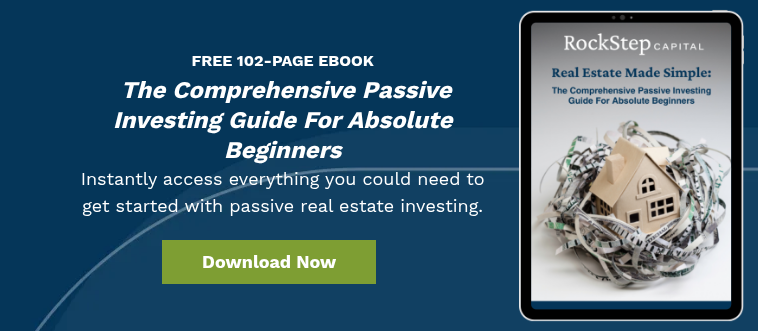Massive Distinctions Between A Syndication & Fund For New Investors
February 10th, 2025
5 min read

A syndication pools investor capital into one specific property and aims for higher returns. At the same time, a fund spreads its investment across multiple assets to diversify and facilitate easier entry. Syndications offer more control and upside, but often require longer holds and higher risk. Funds provide diversification and passive exposure, but may yield lower gains.
New to passive real estate investing and completely lost on whether to choose a syndication or fund structure? You're about to discover the critical differences that could make or break your investment strategy.
Investing passively in real estate can be a liberating experience. You are free from the day-to-day management of tenant complaints, property maintenance, and lease negotiations. These structures give you the freedom to focus on your other interests while your investment grows.
Think of passive real estate investing as a choice between a cruise ship and a sailboat. With a sailboat, you’re responsible for navigating the waters, adjusting the sails, and steering through storms. But on a cruise ship, an experienced captain and crew handle all that while you relax and enjoy the journey. Syndications and pooled funds are your cruise ships in real estate investing—offering a smoother, hands-free path toward financial growth, guided by the expertise of professional managers.
However, not all passive investment structures work the same way. Some offer more flexibility, while others provide higher returns in exchange for a longer commitment. Below, we’ll break down the key options—syndications, open-end pooled funds, and closed-end pooled funds—so you can determine which one best fits your financial goals.
This article will lay out the distinctions, strengths, and weaknesses of these three investment structures while offering insights into which kind of investor each is best suited for.
Understanding Your Investment Options: A Quick Comparison
Before diving into the details, here’s a high-level comparison of the three main passive real estate investment structures:

Now, let’s break down these options one at a time.
1. Syndications: A Group Project With a Defined Goal
A real estate syndication is an investment structure in which multiple investors pool their capital to acquire a specific commercial property. Unlike investing in a real estate fund, where money is spread across various assets, syndication focuses on a single deal, such as an apartment complex, shopping center, or office building.
A real estate syndication is like going in on a vacation home with a group of friends—except instead of a vacation home, you’re investing in a commercial property. One person (the sponsor) takes charge of finding and managing the property, while the rest (the investors) contribute capital and share in the profits.
How a Syndication Works:
- The sponsor (also called the general partner or GP) finds the property, arranges financing, and oversees management.
- The investors (limited partners or LPs) provide capital and receive a percentage of rental income and profits.
- Returns come from rental income and property appreciation, with periodic distributions and a final payout when the property is sold.
Types of Real Estate Syndications
There are two primary types of real estate syndications:
- Equity Syndications: Investors own a portion of the property and receive rental income and a share of profits when the property is sold.
- Debt Syndications: Investors act as lenders, earning fixed interest payments rather than property ownership. These are typically lower-risk but also offer lower returns.
Pros of Syndications
- Hands-off Investing: the sponsor handles operations while you collect passive income.
- Access to Larger Deals: syndications allow investors to own part of high-value commercial properties.
- Strong Return Potential: gains come from rental income and property appreciation.
- Variety of Options: syndications allow you to decide which properties to invest in.
Cons of Syndications
- Long Holding Period: syndications typically last 5-10 years, so funds are tied up.
- Illiquidity: you can’t exit until the property is sold.
- Reliance on the Sponsor: the investment’s success depends on their expertise.
Essentially, syndications are great for investors who want direct ownership in a single commercial property but don’t want to handle management duties.
2. Pooled Funds: Investing in a Managed Portfolio
If syndications are like co-owning a vacation home, then pooled funds are like investing in a mutual fund for real estate. Instead of putting all your money into one property, you spread your investment across multiple assets managed by professionals who handle buying, selling, and optimizing the portfolio.
There are two types of pooled real estate funds: open-end and closed-end. Each offers a different level of flexibility and return potential.
A. Open-End Funds: A Buffet of Investment Options
An open-end real estate fund is an investment fund that continuously raises capital and allows investors to enter and exit at periodic intervals. Unlike syndications with a set exit point, open-end funds offer ongoing liquidity, meaning investors can redeem their shares (cash out) at specific times, such as quarterly or annually. The fund manager actively buys, sells, and manages properties within the portfolio to maximize returns.
In other words, an open-end fund is like a high-end restaurant buffet: you can invest (enter) whenever you want and exit at designated intervals, just like you can come and go at a buffet while the restaurant continues to operate. The fund manager actively buys and sells properties to optimize the portfolio.
Pros of Open-End Funds
- Liquidity: more flexibility to redeem investments than syndications.
- Diversification: your money is spread across multiple properties, reducing risk.
- Professional Management: experts handle asset selection and strategy.
Cons of Open-End Funds
- Returns Fluctuate: since properties are continuously bought and sold, profits vary.
- Limited Redemption Options: unlike stocks, you can’t cash out instantly.
- Management Fees: fund managers charge fees that impact net returns.
Open-end funds are great for investors who want diversification, some liquidity, and passive exposure to commercial real estate.
B. Closed-End Funds: A Slow-Cooked Investment For Maximum Flavor
A closed-end fund is a pooled investment where investors commit capital upfront, and the fund manager deploys that capital to acquire, improve, and eventually sell real estate assets. Unlike open-end funds, which allow continuous investment and withdrawals, closed-end funds have a fixed lifespan, typically 7-10 years. Investors receive distributions over time and a final payout when the fund liquidates its assets.
A closed-end fund is like a slow-cooked gourmet meal. You commit your ingredients (capital) upfront, wait patiently while the chef (fund manager) works their magic, and finally enjoy a rich, flavorful dish when it’s ready.
Pros of Closed-End Funds
- Potential For Higher Returns: value-add strategies can yield stronger profits.
- Defined Exit Strategy: investors know upfront when the fund will close.
- Professional Asset Management: experts handle acquisitions, improvements, and sales.
Cons of Closed-End Funds
- Locked-in Capital: you cannot access funds until the investment term ends.
- Higher Risk: success depends on the fund manager’s execution.
- Longer Time Horizon: investments typically last 7-10 years.
Closed-end funds suit investors who can commit long-term capital for the potential of higher gains.
Why This Matters For Investors
Understanding passive real estate investment structures is essential for investors looking to build long-term wealth. Different structures serve different financial objectives, so choosing the right one depends on an investor’s risk tolerance, desired level of involvement, and time horizon.
Passive real estate investing isn’t a one-size-fits-all approach. Making an informed choice today can set the stage for steady cash flow, long-term appreciation, and a strong real estate investment portfolio in the future.
Finding The Right Fit For Your Investment Goals
Passive real estate investing opens the door to steady income, portfolio growth, and long-term wealth—all without the hassle of managing properties yourself. However, choosing an investment structure that aligns with your financial goals and comfort level is key to success.
If you like the idea of owning part of a high-value property with strong return potential, a syndication could be a great fit—as long as you're comfortable committing for several years. If diversification and flexibility are more important to you, an open-end fund provides exposure to multiple properties with the option to enter or exit periodically. And if you're willing to lock in capital for bigger potential gains, a closed-end fund lets you invest in a portfolio designed for long-term appreciation.
No matter which route you take, smart investing starts with smart learning. If you want to deepen your knowledge of passive real estate, retail property investments, or the shopping center sector, check out our Learning Center. We break down complex topics into simple, actionable insights so you can invest with confidence. The best opportunities go to those who are prepared. Take the time to learn and let your money start working for you.
Topics:



























